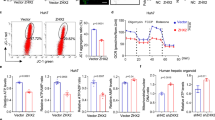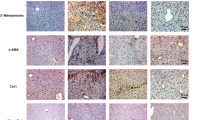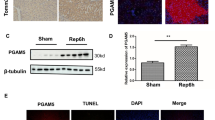Abstract
Augmenter of liver regeneration (ALR) contributes to mitochondrial biogenesis, maintenance and to the physiological operation of mitochondria. The depletion of ALR has been widely studied and had serious consequences on the mitochondrial functions. However the inverse direction, the effect of the depletion of mitochondrial electron transfer chain and mtDNA on ALR expression has not been investigated yet. Thus mtDNA depleted, ρ0 cell line was prepared to investigate the role of mitochondrial electron transfer chain and mtDNA on ALR expression. The depletion of mtDNA has not caused any difference at mRNA level, but at protein level the expression of ALR has been markedly increased. The regulatory role of ATP and ROS levels could be ruled out because the treatment of the parental cell line with different respiratory inhibitors and uncoupling agent could not provoke any changes in the protein level of ALR. The effect of mtDNA depletion on the protein level of ALR has been proved not to be liver specific, since the phenomenon could be observed in the case of two other, non-hepatic cell lines. It seems the level of mtDNA and/or its products may have regulatory role on the protein level of ALR. The up-regulation of ALR can be a part of the adaptive response in ρ0 cells that preserves the structural integrity and the transmembrane potential despite the absence of protein components encoded by the mtDNA.



Similar content being viewed by others
References
Francavilla A, Hagiya M, Porter KA, et al. (1994) Augmenter of liver regeneration: its place in the universe of hepatic growth factors. Hepatology 20:747–757
Hagiya M, Francavilla A, Polimeno L, et al. (1994) Cloning and sequence analysis of the rat augmenter of liver regeneration (ALR) gene: expression of biologically active recombinant ALR and demonstration of tissue distribution. Proc Natl Acad Sci U S A 91:8142–8146. doi:10.1073/pnas.92.7.3076a
Giorda R, Hagiya M, Seki T, et al. (1996) Analysis of the structure and expression of the augmenter of liver regeneration (ALR) gene. Mol Med 2:97–108
Lisowsky T, Weinstat-Saslow DL, Barton N, et al. (1995) A new human gene located in the PKD1 region of chromosome 16 is a functional homologue to ERV1 of yeast. Genomics 29:690–697
Lisowsky T (1992) Dual function of a new nuclear gene for oxidative phosphorylation and vegetative growth in yeast. Mol Gen Genet 232:58–64
Lisowsky T (1994) ERV1 is involved in the cell-division cycle and the maintenance of mitochondrial genomes in Saccharomyces cerevisiae. Curr Genet 26:15–20
Lisowsky T (1996) Removal of an intron with unique 3′ branch site creates an amino-terminal protein sequence directing the scERV1 gene product to mitochondria. Yeast 12:1501–1510. doi:10.1002/(SICI)1097-0061(199612)12:15<1501::AID-YEA40>3.0.CO;2-H
Lange H, Lisowsky T, Gerber J, et al. (2001) An essential function of the mitochondrial sulfhydryl oxidase Erv1p/ALR in the maturation of cytosolic Fe/S proteins. EMBO Rep 2:715–720
Lisowsky T, Lee JE, Polimeno L, et al. (2001) Mammalian augmenter of liver regeneration protein is a sulfhydryl oxidase. Dig Liver Dis 33:173–180
Mesecke N, Terziyska N, Kozany C, et al. (2005) A disulfide relay system in the intermembrane space of mitochondria that mediates protein import. Cell 121:1059–1069. doi:10.1016/j.cell.2005.04.011
Dabir DV, Leverich EP, Kim S-K, et al. (2007) A role for cytochrome c and cytochrome c peroxidase in electron shuttling from Erv1. EMBO J 26:4801–4811. doi:10.1038/sj.emboj.7601909
Bihlmaier K, Mesecke N, Terziyska N, et al. (2007) The disulfide relay system of mitochondria is connected to the respiratory chain. J Cell Biol 179:389–395. doi:10.1083/jcb.200707123
Glerum DM, Shtanko A, Tzagoloff A (1996) Characterization of COX17, a yeast gene involved in copper metabolism and assembly of cytochrome oxidase. J Biol Chem 271:14504–14509
Beers J, Glerum DM, Tzagoloff A (1997) Purification, characterization, and localization of yeast Cox17p, a mitochondrial copper shuttle. J Biol Chem 272:33191–33196
Szarka A, Bánhegyi G (2011) Oxidative folding: recent developments. Biomol Concepts 2:1–12. doi:10.1515/BMC.2011.038
Di Fonzo A, Ronchi D, Lodi T, et al. (2009) The mitochondrial disulfide relay system protein GFER is mutated in autosomal-recessive myopathy with cataract and combined respiratory-chain deficiency. Am J Hum Genet 84:594–604. doi:10.1016/j.ajhg.2009.04.004
Thirunavukkarasu C, Wang LF, Harvey S a K, et al. (2008) Augmenter of liver regeneration: an important intracellular survival factor for hepatocytes. J Hepatol 48:578–588. doi:10.1016/j.jhep.2007.12.010
Gandhi CR, Chaillet JR, Nalesnik M a, et al. (2015) Liver-specific deletion of augmenter of liver regeneration accelerates development of steatohepatitis and hepatocellular carcinoma in mice. Gastroenterology 148:379–391.e4. doi:10.1053/j.gastro.2014.10.008
Falkenberg M, Larsson N-G, Gustafsson CM (2007) DNA replication and transcription in mammalian mitochondria. Annu Rev Biochem 76:679–699. doi:10.1146/annurev.biochem.76.060305.152028
King MP, Attardi G (1996) Isolation of human cell lines lacking mitochondrial DNA. Methods Enzymol 264:304–313
Trimmer P a, Keeney PM, Borland MK, et al. (2004) Mitochondrial abnormalities in cybrid cell models of sporadic Alzheimer’s disease worsen with passage in culture. Neurobiol Dis 15:29–39. doi:10.1016/j.nbd.2003.09.011
Dayoub R, Wagner H, Bataille F, et al. (2011) Liver regeneration associated protein (ALR) exhibits antimetastatic potential in hepatocellular carcinoma. Mol Med 17:221–228. doi:10.2119/molmed.2010.00117
Gandhi CR (2012) Augmenter of liver regeneration. Fibrogenesis Tissue Repair 5:10. doi:10.1186/1755-1536-5-10
Miranda S, Foncea R, Guerrero J, Leighton F (1999) Oxidative stress and upregulation of mitochondrial biogenesis genes in mitochondrial DNA-depleted HeLa cells. Biochem Biophys Res Commun 258:44–49. doi:10.1006/bbrc.1999.0580
Boveris A, Chance B (1973) The mitochondrial generation of hydrogen peroxide. General properties and effect of hyperbaric oxygen. Biochem J 134:707–716
Lee MS, Kim JY, Park SY (2004) Resistance of ρ0 cells against apoptosis. Ann N Y Acad Sci 1011:146–153. doi:10.1196/annals.1293.015
Holmuhamedov E, Jahangir A, Bienengraeber M, et al. (2003) Deletion of mtDNA disrupts mitochondrial function and structure, but not biogenesis. Mitochondrion 3:13–19. doi:10.1016/S1567-7249(03)00053-9
Li K, Neufer PD, Williams RS (1995) Nuclear responses to depletion of mitochondrial DNA in human cells. Am J Physiol 269:C1265–C1270
Ilowski M, Kleespies A, de Toni EN, Donabauer B, Jauch KW, Hengstler JG, Thasler WE (2011) Augmenter of liver regeneration (ALR) protects human hepatocytes against apoptosis. Biochem Biophys Res Commun 404(1):148–152
Acknowledgments
This work was financially supported by National Scientific Research Fund grant (OTKA 105416) and MedinProt Protein Excellence foundation. Tamás Lőrincz is a Gedeon Richter Plc Talentum fellowship recipient.
Author information
Authors and Affiliations
Corresponding author
Rights and permissions
About this article
Cite this article
Balogh, T., Lőrincz, T., Stiller, I. et al. The Level of ALR is Regulated by the Quantity of Mitochondrial DNA. Pathol. Oncol. Res. 22, 431–437 (2016). https://doi.org/10.1007/s12253-015-0020-y
Received:
Accepted:
Published:
Issue Date:
DOI: https://doi.org/10.1007/s12253-015-0020-y




